
* The SAAB company of Sweden is well-known for developing a series of distinctive and excellent jet fighters, but SAAB has also produced a series of trainers. This document provides a history and description of SAAB trainers, including the piston-engine "Safir", the jet-powered "SAAB 105 / Sk 60", and the piston-powered "Supporter". A list of illustration credits is included at the end.

* In 1944, SAAB of Sweden began work on a light three-seat piston aircraft, leading to initial flight of a prototype for the "SAAB 91 Safir (Sapphire)" on 20 November 1945. The Safir was a low-wing monoplane, of metal construction except for part of the wings and the control surfaces, which were fabric over metal framing. It featured retractable tricycle landing gear, and a British de Havilland Gipsy Major 1C inverted inline four-cylinder air-cooled engine with 97 kW (130 HP), driving a two-blade variable-pitch propeller.
Successful test and evaluation of the single prototype led to the first production version, the "SAAB 91A", with a more powerful Gipsy Major 10 engine providing 110 kW (147 HP). Production began in 1946, with 48 built to 1948. Ten were obtained by the Swedish Air Force, the Flygvapnet, for service as liaison aircraft; they were designated "Tp 91" and remained in service to 1960. The Netherlands state air transport school bought eight SAAB 91A Safirs, while the Ethiopian Air Force obtained 16. The rest were bought by private users.
_______________________________________________________________
SAAB 91A SAFIR:
_______________________________________________________________
wingspan:
10.6 meters (34 feet 9 inches)
wing area:
13.6 sq_meters (146.31 sq_feet)
length:
7.85 meters (25 feet 9 inches)
height:
2.2 meters (7 feet 3 inches)
empty weight:
580 kilograms (1,280 pounds)
MTO weight:
995 kilograms (2,195 pounds)
maximum speed:
265 KPH (165 MPH / 145 KT)
service ceiling:
4,600 meters (15,000 feet)
range:
940 kilometers (585 MI / 510 NMI)
_______________________________________________________________
The initial Safir prototype had an interesting career. In 1947, it was fitted with swept wings to model those for the SAAB 29 Tunnan jet fighter, and redesignated "SAAB 201". In 1950, it was similarly fitted with wings to model those of the SAAB 32 Lansen fighter and redesignated "SAAB 202".
* The Flygvapnet became interested in the Safir as a primary flight trainer, and in response SAAB came up with a more powerful variant, the "SAAB 91B", featuring a US Lycoming O-435-A flat-six air-cooled engine with 140 kW (190 HP), and minor changes such as an improved canopy. Weight increased by about 20%, while the maximum speed improved marginally. Initial flight of the SAAB 91B Safir was on 18 January 1949. A four-seater version, the "SAAB 91C", was implemented by removing a fuselage fuel tank and adding tanks in the wings, with initial flight of this variant in September 1953.

Since SAAB's manufacturing capacity was overloaded with production of the Tunnan fighter at the time, in 1952, 1953, and 1954 SAAB 91B production was farmed out to de Scheldewerke in the Netherlands, with 120 machines built there. Safir production reverted to SAAB in 1955.
The Flygvapnet obtained 75 SAAB 91B Safirs for training under the military designation of "Sk 50B", and then bought 14 SAAB 91C Safirs as the "Sk 50C". One of the Sk 50B machines was sold back to SAAB shortly after delivery, to be sold in turn in 1957 to the Japanese Technical Research & Development Institute (TRDI), part of the Japan Defense Agency, where it was modified as a short takeoff or landing (STOL) demonstrator. The Safir's wings were easily swapped out, making it a handy trials platform. This machine was used for a wide range of experiments, to be finally retired in 1987. It is now on display in a museum in Japan.
Other military users included:
The Norse SAAB 91Bs were actually a unique hybrid designated the "SAAB 91B-2", a SAAB 91B with SAAB 91C wings without internal wing tanks. Civil users included:
* The final production version, the "SAAB 91D", was introduced in 1957 and featured a lighter Lycoming O-360-A1A engine with 135 kW (180 HP), disk brakes, and a number of weight-saving refinements. The Austrian Air Force bought 24 as trainers; other users included the Finnish Air Force (16, two of which were fitted with cameras and used as tactical reconnaissance aircraft); the Netherlands (18); and the Tunisian Air Force (15).
A total of 323 Safirs was built up to end of production in 1966. The type was withdrawn from the training role in Sweden in 1971, but remained in use in the liaison and hack roles up to the early 1990s. The Safirs still flying were then sold off cheaply to flying clubs.
BACK_TO_TOP* In the late 1950s, SAAB engineers began to dream up designs for a small high-speed business jet, coming up with exotic concepts including one with a delta wing, canard foreplanes, and seating for five. The company also had an eye on the military market: the Flygvapnet was fielding the Mach 2 SAAB 35 Draken fighter and the service's current advanced jet trainer, the de Havilland Vampire, was really not adequate for preparing pilots to fly supersonic aircraft. SAAB soon realized that military applications had greater potential than commercial applications, and in April 1960 the company relaunched the project as the "SAAB 105", a multirole aircraft of more conventional design. The effort was company-funded and conducted by a design team under Ragnar Haerdmark.
Conveniently, at about the same time the Flygvapnet issued a request for an advanced trainer / light strike aircraft, and SAAB engineers tweaked the design to meet the requirement. Although the Flygvapnet evaluated a number of foreign aircraft for the requirement -- including the British Hunting Jet Provost, the French Fouga Magister, the Italian Macchi MB.326, and the Canadair Tutor -- in the end the decision was made to "buy local", even though the SAAB 105 was strictly a paper aircraft at the time. On 16 December 1961, the Swedish government awarded SAAB a contract for a prototype and signed a letter of intent for at least a hundred production machines.
Initial flight of the first SAAB 105 prototype was on 29 June 1963, with test pilot Karl-Erik Fernberg at the controls. A second prototype performed its first flight on 17 June 1964. The first prototype was lost in a crash during inverted spinning trials in 1966, the pilot ejecting safely. The second had a long career, discussed below, and was finally retired to a museum in 1992.
* The SAAB 105 had side-by-side seating; a shoulder-mounted wing with a slight sweep and anhedral droop; airbrakes; a tee tail, and twin engines. It was of all-metal construction, with two fuel tanks in the fuselage and a fuel tank in each wing, for a total of four internal tanks.
Control surfaces were orthodox, with outboard ailerons and inboard flaps on the wing, and elevators and rudder on the tee tail arrangement. The airbrakes were of unconventional configuration: typically airbrakes are hinged panels that are pushed out from the fuselage forward into the airflow, but in the SAAB 105 they looked more like perforated wedges with curved sides and a hinge on one corner, being rotated sideways out of the fuselage behind the main gear. Some sources claim there were spoilers, but it is very difficult to see them in any photographs or models. The prototype had a single fence on each wing; production aircraft had two fences on each wing. There was a small ventral fin under the tail.
The SAAB 105 had tricycle landing gear, all with single wheels, the nose gear retracting forward and the main gear tucking into the fuselage. The landing gear was close to the ground, easing servicing. The engines were originally French Turbomeca Aubisque turbofans, with 7.31 kN (745 kgp / 1,642 lbf) thrust each, with the designation "RM9" in Swedish service. SAAB engineers had also considered the Turbomeca Marbore 6 turbojet, but decided it lacked adequate thrust and fuel economy, and looked over the US General Electric (GE) J85 turbojet, but decided it was too expensive -- though that idea would be revisited. The Aubisque engines were later uprated to the more powerful "RM9B" variant, with 7.31 kN (745 kgp / 1,642 lbf) thrust.
The crew sat on SAAB ejection seats under a clamshell canopy that hinged open to the rear; there was a small window on each side of the fuselage behind the canopy. The ejection seats were not capable of "zero-zero (zero altitude, zero speed)" operation. Avionics were basic. There was provision for three stores pylons under each wing, for a total of six; the first prototype originally had only one pylon under each wing. There were no provisions for centerline stores, since the short landing gear made centerline carriage impractical.
BACK_TO_TOP* The Flygvapnet eventually obtained 150 SAAB 105 aircraft, under the general designation of "Sk 60". The first production aircraft flew on 27 August 1965, with all production machines delivered from 1966 to 1969. Although old photographs of the Sk 60 often show aircraft in natural metal finish, in service they eventually were generally given a more-or-less standard color scheme of dark green and brown disruptive camouflage, with gray undersides.
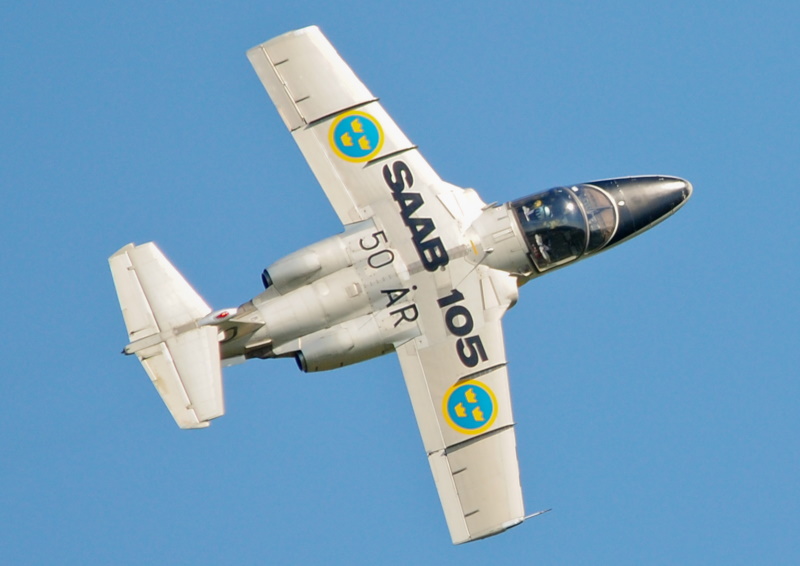
Sk 60 variants are something of a confusing issue. 149 were delivered as unarmed "Sk 60A" advanced trainers. However, as mentioned, the SAAB 105 had been designed with a secondary light attack role in mind, and when fitted with the six stores pylons and a Ferranti F-105 Integrated Strike & Interception System (ISIS) multifunction sight (in front of the left / pilot's seat), the type was referred to as the "Sk 60B". The Sk 60B also had provisions for the control system for the Rb 05 air-to-surface missile (ASM) -- a radio-guided weapon, comparable to the US Bullpup A -- but this capability was never actually used in service.
About 45 Sk 60A machines were fitted out to Sk 60B specification. The Sk 60B could carry:
None of the pylons were "wet", so external tanks couldn't be carried. Total weight of external stores was a maximum of 700 kilograms (1,540 pounds).
_______________________________________________________________
SAAB 105 / SK-60B:
_______________________________________________________________
wingspan:
9.5 meters (31 feet 2 inches)
wing area:
16.3 sq_meters (175.46 sq_feet)
length:
10.5 meters (34 feet 5 inches)
height:
2.7 meters (8 feet 10 inches)
empty weight:
2,510 kilograms (5,535 pounds)
normal weight:
4,050 kilograms (8,930 pounds)
MTO weight:
4,500 kilograms (9,920 pounds)
maximum speed:
770 KPH (480 MPH / 420 KT)
service ceiling:
13,500 meters (44,300 feet)
range:
1,400 kilometers (870 MI / 755 NMI)
_______________________________________________________________
* In the mid-1960s, the Flygvapnet decided that it would be nice to have an enhanced light-strike version of the Sk 60 that could also be used for reconnaissance and forward air control (FAC) missions. The result was the "Sk 60C", with the prototype performing its first flight on 18 January 1967.
The primary distinguishing feature of the Sk 60C was a lengthened camera nose, accommodating a single Fairchild KB-18 panoramic film camera. The Sk 60C could also carry a photoflash pod on a wing pylon for night photography. The reconnaissance role was later de-emphasized for the Sk 60C, and the camera ports in the nose were faired over in some machines. The Sk 60C prototype was the only new-build Sk 60C; it was delivered to the Flygvapnet, making it the 150th and last new-build Sk 60 in Swedish service. 28 more Sk 60Cs were built as conversions of Sk 60A/B aircraft.

* SAAB had also designed the SAAB 105 for use as a four-seat liaison transport: the two ejection seats could be yanked, and quickly replaced with four comfy airline-type seats, with no provision for wearing a parachute; or four more austere seats that allowed parachutes. In the mid-1970s, ten Sk 60A machines were permanently configured as four-seat transports and given the designation of "Sk 60D". Some were painted in the relatively flashy light green / dark green / tan "splinter" camouflage associated with the SAAB Viggen fighter.
The "Sk 60E" variant was a similar four-seat Sk 60A conversion, but featured commercial-type instruments, including an instrument landing system. It was used to help train Flygvapnet reserve pilots in flying commercial aircraft. The Sk 60E machines were eventually used as Sk 60D liaison transports.
* Although SAAB worked on a next-generation trainer / light attack machine, the "SAAB B3LA", it was canceled in 1979, leaving the Sk 60 to soldier on. Between 1988 and 1991, the 142 surviving Flygvapnet Sk 60s were given structural reinforcement; new wings; and modifications to the ejection seats for fit of a new parachute.
In 1993, another upgrade program was initiated to bring the Sk 60 into the 21st century, the most important improvement being fit of twin Williams Rolls FJ44 turbofans with 8.45 kN (861 kgp / 1,900 lbf) each and digital engine controls. The new engines not only provided more thrust, but were much quieter, cleaner, and easier to maintain. The first Williams-powered Sk 60 -- known informally as the "Sk 60(W)" -- performed its initial flight in August 1995. A total of about 115 conversions of Sk 60A, Sk 60B, and Sk 60C machines was performed in the late 1990s. No conversions were performed of the Sk 60D/E, with all such aircraft grounded and used as spares hulks. There was talk of upgrading the archaic and increasingly decrepit cockpit instrument system to feature two multifunction displays (MFDs), but it is unclear if this idea ever got out of the talk stage.

The re-engined Sk 60 remains in Flygvapnet service -- though the Sk 60C is not used in training, the extended nose complicating stall recovery. The type is not only retained in training and secondary strike roles, but is also used as the mount for the Flygvapnet "Team 60" flight demonstration group. Team 60 uses six aircraft and is staffed by Flygvapnet flight instructors; it is operated on a roughly seasonal basis. However, the Flygnapnet is now casting about for a replacement trainer, and the Sk 60 is expected to be out of service by 2025. No one could say it had too short a life.
BACK_TO_TOP* SAAB had considered selling the SAAB 105 as a business jet, and went so far as to display a model of such a variant at the Hanover Air Show in Germany in 1966. The "SAAB 105C", as it was designated, featured a redesigned pressurized cockpit with four or five seats and a wingspan stretched to 11 meters (35 feet 9 inches) to accommodate more fuel. Although a refined business jet variant, the "SAAB 105D", was considered, the concept was out of date, and there were no takers.
* In the same timeframe, SAAB worked on a military export model of the SAAB 105, flying a demonstrator, the "SAAB 105XT", for the first time on 29 April 1967. It was a modification of the hard-working second SAAB 105 prototype. This variant had more powerful GE J85-GE-17B turbojets, with 12.6 kN (1,290 kgp / 2,845 lbf) thrust each. In conjunction with an improved wing structure, the greater power increased the stores limit to 2 tonnes (4,400 pounds). The SAAB 105XT was wired for carriage of US-designed AIM-9J Sidewinder air-to-air missiles (AAM), built under license in Sweden as the "RB 24".
The target customers were third-world nations, the "XT" standing for "eXport Tropic"; it was promoted for training, light strike, reconnaissance, liaison, and target-tug roles. A dedicated reconnaissance version was considered, featuring the Sk 60C camera nose and twin fairings for side-looking airborne radar (SLAR) on each side of the fuselage, giving its nose something of the appearance of a sled.
Austria ordered 20 SAAB 105XT machines with the designation of "SAAB 105OE" ("OE" for "Oesterreich / Austria") in 1968, and then bought 20 more in 1969, for a total of 40. Initial deliveries were in 1970 and were completed in 1972. They replaced old SAAB 29 Tunnan fighters in Austrian service, and were tasked with the reconnaissance, close support, and air defense missions. The J85 engines were a big plus, since Austria is a generally Alpine country and more thrust was needed for high-altitude take-offs.
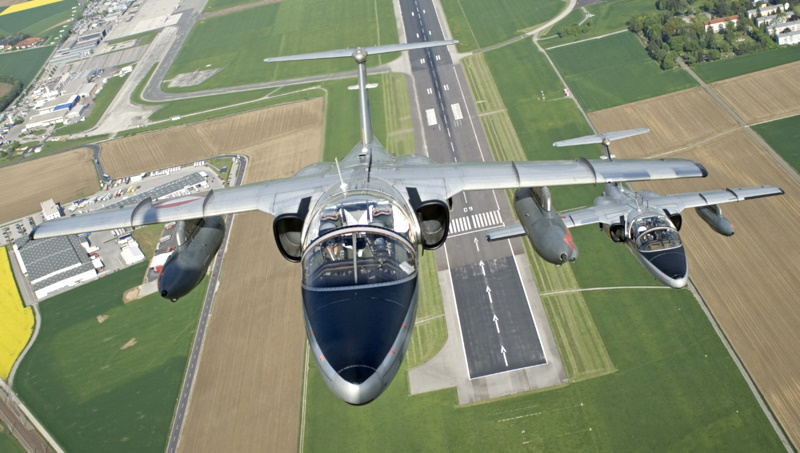
For the reconnaissance mission, the SAAB 105OE could carry a Vinten film camera pod, built specifically for Austrian service, with one forward and four downward/oblique cameras, under the left wing, plus a photoflash pod under the right wing. For the strike mission, the SAAB 105OE carried unguided rockets, which were apparently the weapon used for the air defense role as well. Some sources claim they carried Sidewinder AAMs, but other sources indicate that Austria was restricted by treaty from using guided AAMs until after the fall of the Soviet Union. In 2019, the SAAB 105OE machines were grounded because of structural problems; by that time, only a handful of them were still flying. The Austrians wanted to repair them, since they were so economical to operate, compared to Austrian Eurofighters, but finally decided to retire them permanently.
* In 1970, SAAB proposed an improved SAAB 105XT variant designated the "SAAB 105XH", for the Swiss market, the "XH" standing for "Export Helvetia", in reference to the old Latin name for Switzerland. The 105XH featured:
Eventually, the Swiss filled their requirement with refurbished Hawker Hunters and new-build US Northrop F-5E Tiger II fighters.
SAAB flew a demonstrator for another improved SAAB 105XT variant, the "SAAB 105G", updating the SAAB 105 second prototype / SAAB 105XT demonstrator to this standard in 1972. It was essentially the SAAB 105XT with a comprehensive navigation-attack system -- featuring the SAAB BT9R system, a rolling-map display, an inertial navigation system, and an air data computer. There were no takers, but the SAAB 105G demonstrator kept on flying in the test and trials role until it was finally retired in 1992. In the mid-1970s, SAAB proposed yet another SAAB 105XT demonstrator, the "SAAB 105S" for a Finnish trainer requirement, but the Finns decided to buy the BAE Hawk instead.
BACK_TO_TOP* Following the introduction of the SAAB 105 / Sk 60, SAAB took something of a step backward and developed another piston trainer -- or maybe "sort of" developed "sort of" a trainer would be more correct to say, the story being complicated.
It started in the late 1950s, when aircraft designer Bjoern Andreasson, then working for Convair in the US, developed as a "garage job" a two-seat lightplane, the "BA-7", which performed its first flight on 10 October 1958. It was a tidy little aircraft, with a slightly forward-swept high-mounted strut-braced wings, fixed tricycle landing gear, and a glass-roofed cockpit that provided a good field of view. The tail arrangement was conventional in appearance, though originally all three tail surfaces had been "all moving"; the all-moving tailfin was later abandoned in favor of a fixed tailfin with rudder. The aircraft was powered by a Continental A75 flat-four air-cooled engine providing 56 kW (75 HP), driving a two-bladed variable-pitch prop.
Andreasson had worked in the Swedish aircraft industry during the war, and in 1960 he returned home to Sweden to work for AB Malmoe FlygIndustri (MFI), a successor organization to that which had employed him earlier, working to help put an improved version of the BA-7 into production as the "MFI-9 Junior". Trials began in May 1961, leading to the flight of the first production aircraft on 9 August 1962, featuring a larger cockpit and a Continental O-200-A flat-four air-cooled piston engine providing 75 kW (100 HP).
The MFI-9 was followed in 1963 by the "MFI-9B Trainer", which had a bigger and rearranged cabin, a larger tail assembly, and electrically-operated flaps; and then "MFI-9B Mil-Trainer", which had reinforced wings and pylons to allow it to carry underwing stores including rockets, rocket pods, gun pods, or camera pods. It was promoted both as a trainer and a (very) light attack aircraft, able to operate off of rough short airstrips near the fighting lines. The Flygvapnet leased ten MFI-9B machines for evaluation as a primary trainer, with all ten being evaluated in 1966 and given the military designation of "FPL-801". The Flygvapnet concluded that the type did not meet the needs of the service and returned the aircraft, adopting the Scottish Aviation Bulldog as the "Sk 61" instead.
* However, the MFI-9B did see combat service as a "flying guerrilla fighter" in an adventure that would make for a pretty good low-budget action movie. In 1967, the province of Biafra seceded from Nigeria, sparking a three-year civil war. Biafra was blockaded and the people there began to starve, leading to an international airlift effort to bring in supplies.
One of the relief pilots was a Swede, Carl Gustaf von Rosen, who decided to take a more active approach to helping the Biafrans. Working with the Biafrans, he obtained five MFI-9Bs, with the aircraft assembled in Gabon in the spring of 1969. They were given a green camouflage paint scheme, a simple gunsight, and pylons to carry a rocket pod under each wing, with each pod containing six French SNEB / Brandt 68-millimeter (2.68-inch) unguided folding-fin rockets with armor-piercing warheads, for a total of 12 rockets per aircraft. That gave them enough firepower to make thorough nuisances of themselves. The aircraft were called "Biafra Babies".
The Babies began attacks in May 1969, hitting targets such as Nigerian MiG fighters and Ilyushin bombers on the ground. There were originally three Swedish and three Biafran pilots for the fleet, and they learned to conduct strikes at dusk and dawn, coming in low over the treetops, maintaining radio silence until the last moment, firing at ranges of a few hundred meters, and then departing as quickly as possible. The exact details of their operations remain a bit unclear, with a few shot down and some North American AT-6 Texans joining the fleet. The Biafran rebellion was finally stamped out in early 1970.
* The MFI-9 was also produced under license in Germany by Boelkow Appartebau GMBH in Nabern-Teck -- by the end of the 1960s part of the Messerschmitt-Boelkow-Blohm (MBB) group. Boelkow obtained a license from MFI in July 1961 and flew the first production example of the "Model 208 Junior" in April 1962, this machine being similar or identical to the MFI-9 Junior. German certification was awarded almost exactly a year later.
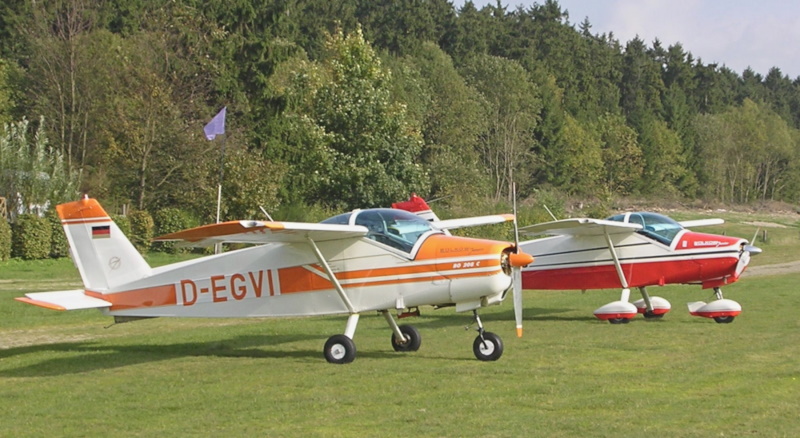
An improved version of the Junior, the "Model 208B", was introduced in 1964; it featured electrically-operated flaps and an optional larger wing. It was followed in turn in 1965 by the "Model 208C", with various refinements. About 250 to 300 MFI-9 and Model 208 machines were built up to end of production in the late 1960s.
* In the mid-1960s MFI began work on a slightly scaled-up version of the MFI-9 for use as a primary trainer or military utility aircraft. MFI was bought out by SAAB in 1968, but the program continued, with a prototype of the "SAAB MFI-15" performing its first flight on 11 July 1969. Its general configuration was very much like that of the MFI-9, with:
The conventional tail assembly with the low-mounted tailplane proved too prone to damage from rocks and the like kicked up by rough-field operation. The prototype was rebuilt with a high tailplane, and was also refitted with a more powerful IO-360-A1B6 engine with 150 kW (200 HP). It returned to flight test in its new configuration on 26 February 1971, and successful flight evaluation led to production as the "MFI-15 Safari". Tailwheel landing gear, better suited to rough-field operations, was available as an option, though it is unclear if any tailwheel Safaris were ever sold.
Most Safaris were sold for private use, but two were sold to the air force of Sierra Leone as pilot trainers, though they were sold off again in a few years. Norway bought 16 Safaris in 1981 as primary trainers to replace the SAAB Safir, with three attrition replacements obtained in 1982:1983 and four more replacements obtained in 1987 -- for a total of 23 Norwegian Safaris.
* In 1972, SAAB modified a Safari for use as a light attack aircraft capable of being fitted with up to six pylons with a total warload of 300 kilograms (660 pounds). Qualified weapons included unguided rockets; two machine-gun pods, each with two guns, for a total of four guns; or six Bantam wire-guided antitank missiles. The type performed its first flight in this configuration on 6 July 1972, and was offered for sale as the "MFI-17 Supporter".
_______________________________________________________________
SAAB MFI-17 SUPPORTER:
_______________________________________________________________
wingspan:
8.85 meters (29 feet)
wing area:
11.90 sq_meters (128.09 sq_feet)
length:
7.0 meters (23 feet)
height:
2.60 meters (8 feet 6 inches)
empty weight:
645 kilograms (1,425 pounds)
normal weight:
1,125 kilograms (2,480 pounds)
MTO weight:
1,200 kilograms (2,645 pounds)
maximum speed:
235 KPH (145 MPH / 125 KT)
service ceiling:
4,100 meters (13,450 feet)
_______________________________________________________________
In 1976, Denmark obtained 32 Supporters under the local designation of "T-17", with these aircraft mostly being used for pilot training by the Danish Air Force, though nine were provided to the Danish Army for utility use and target spotting.
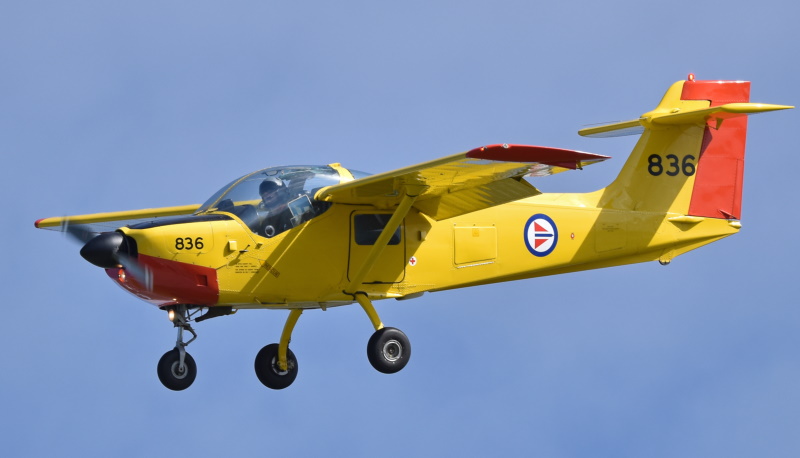
The Zambian Air Force was the third customer for the Supporter, obtaining 20 for counter-insurgency and training roles. SAAB finally terminated production of the Safari / Supporter in the late 1970s, with about 250 built. Most of the production was sold to private fliers; the type does continue in lingering military service.
Pakistan obtained 28 Supporters from SAAB, and then assembled 92 more in a Pakistani factory from knockdown kits provided by SAAB. The type was known as the "Mushshak", an Urdu word meaning "Proficient", in Pakistani service, and was used in training and liaison roles by both the army and air force.
The Mushshak was then put into local production at the Aircraft Manufacturing Factory (AMF), with more than 120 built. 25 of these machines were sold to the Iranian Revolutionary Guards in the early 1990s. Two examples of an improved variant, the "Shahbaz", with an uprated Teledyne Continental turbocharged TIO-360-MB engine with 160 kW (210 HP), the first flying in July 1987.
In the next decade, another improved variant, the "Super Mushshak", was introduced, with a Lycoming IO-540 flat-six engine providing 195 kW (260 HP) and generally updated aircraft systems. The Super Mushshak remains in production. There have been some export sales; Nigeria obtained ten as trainers, being delivered in 2017:2018.
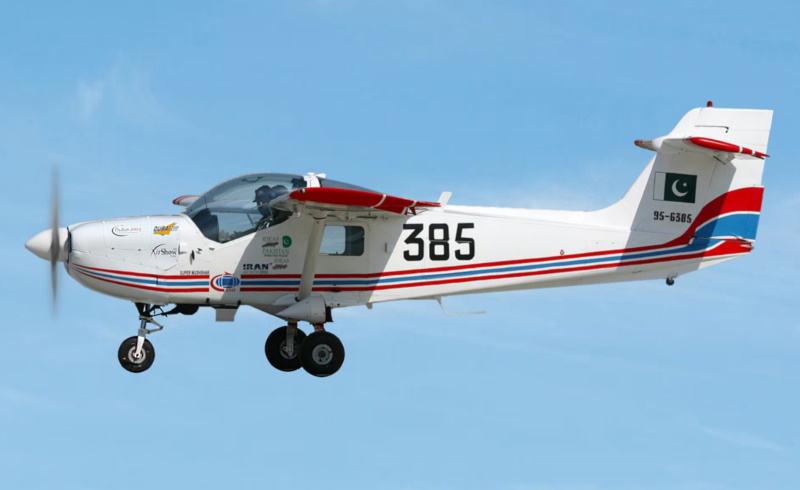
The Pakistani machines are apparently not included in the SAAB production total of about 250. It is unclear what the virtues and faults of this family of aircraft were, but its popularity seems to suggest in itself that it had plenty going for it.
BACK_TO_TOP* Sources include:
I also picked up some nice stuff on the Safir and the MFI-9 at war from Urban Fredriksson's "Swedish Military Aviation Page" -- a fine source on all things Swedish that fly.
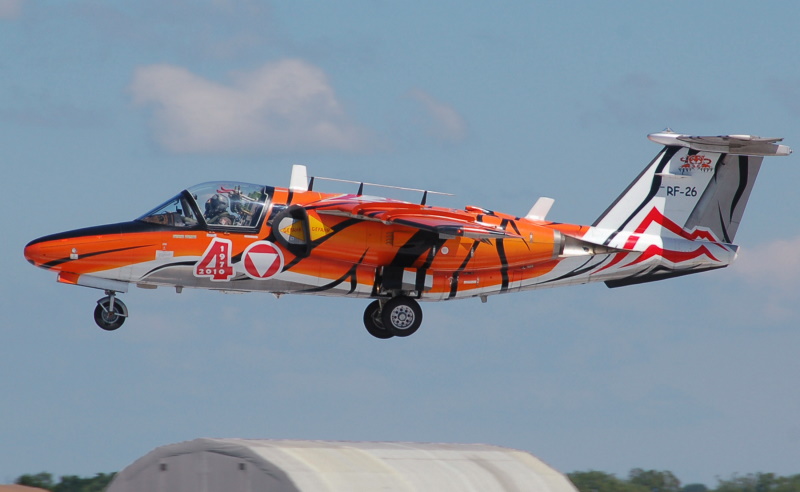
* Illustrations details:
* Revision history:
v1.0.0 / 01 may 04 v1.0.1 / 01 nov 04 / Minor corrections. v1.0.2 / 01 may 06 / Review & polish. v1.0.3 / 01 may 07 / Review & polish. v1.0.4 / 01 apr 09 / Review & polish. v1.0.5 / 01 oct 10 / Review & polish. v1.0.6 / 01 sep 12 / Review & polish. v1.0.7 / 01 aug 14 / Super Mushshak notes. v1.1.0 / 01 jul 16 / Substantial cleanup. v1.1.1 / 01 jun 18 / Review, update, & polish. v1.1.2 / 01 may 20 / Review, update, & polish. v1.1.3 / 01 mar 22 / Review & polish. v1.1.4 / 01 feb 24 / Review & polish.BACK_TO_TOP
